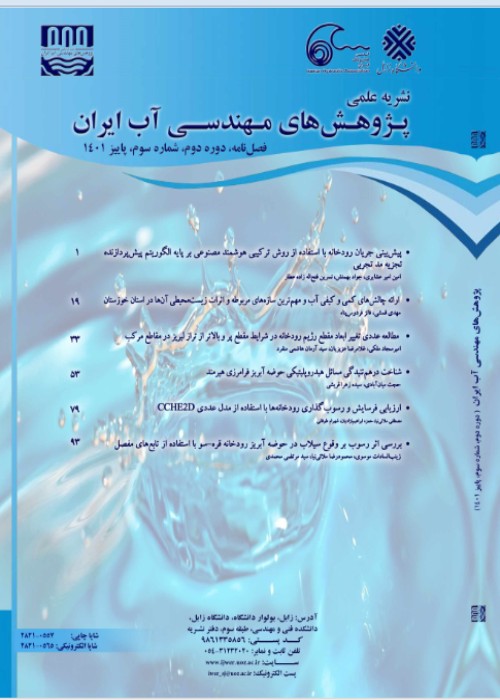Investigation of the effects of hydraulic integration and determination of resilience index in water distribution network systems
An interesting procedure to evaluate the system management policies, including water distribution networks, is to use performance indicators, referring to parameters governing the system performance, including field monitoring, how it works, operation status (Kliseh et al., 2018). In general, two indicators of reliability and resilience are considered in the operation of the water distribution network in urban and rural areas. Hydraulic reliability refers to the continuous supply of a certain amount of water with the required pressures at the desired time and place (Mazaherizadeh et al., 2019) and resilience as the ability of a system or community to survive, absorb and adapt to risk and to protect yourself from the effects of hazards is defined as quickly and efficiently as possible (UNISDR, 2018).Resilience index has been applied to assess the hydraulic needs of the network (Pandit et al., 2012), to evaluate the urban water network infrastructure against earthquakes (Alavi et al., 2018), to optimize the network Water distribution (Reca et al., 2017; Mazaherizadeh et al., 2019), and simultaneous pipe failure assumptions (Gheisi and Naser, 2014; Atashi et al., 2020).In this study, the efficiency of the distribution network in the case of integrating several reservoirs and discrete was investigated and compared using the Resilience index. The distribution network was analyzed based on two scenarios: 1) sufficient flow in the network and 2) essential reversibility of the system.
The water distribution network of Surat, India, with a resilience index of 0.396, can supply water to only 56% of its population (Popawala & Shah, 2011). The area covered by six reservoirs (Fig. 1) was selected to evaluate the city's water distribution network. The resilience index of the distribution network was calculated for both cases of the connected and discrete reservoirs. In the current situation, the reservoirs are connected through transmission lines, and the maximum water level of all reservoirs is the same. Fig. 2 shows the hourly fluctuations of consumption patterns.WaterGEMS software, an upgraded version of WaterCAD software, was used for modeling. This software evaluates the water supply network based on hydraulic conditions and examines the pressure and flow velocity at the node points. This software has more flexibility than other software and also provides the possibility of interacting with other software.To build the model, first, the physic of the distribution network was simulated and the nodal elevations and consumption amounts were allocated. According to the reservoir output pattern and maximum daily and hourly coefficient, consumer consumption pattern was calculated based on the output flow analysis and assigned to the nodes related to each reservoir. Finally, the hydraulic model of the grid was dynamically fabricated for maximum daily consumption, and calibrated for points with very high or shallow pressures over four months at different time intervals.
Fig. 3 shows the outlet pressure ranges of the hydraulic model. In the case of maximum consumption, it changes from 26 to 60 meters in most cases in the current situation. Ten percent of water distribution network nodes in the study area have pressures below 26 meters and more than 60 meters. The most important reason for the equilibrium pressure of the site is the reservoirs connection and the integrity of the water distribution network system throughout the area under study. Also, a minimal number of nodes in the minimum consumption state have pressure above 60 meters affected by night patterns for pressure breakers in the study area.Table 2 shows the pressure in the water distribution network in the state of maximum consumption in integrated and discrete tanks. The rate of nodes with hydraulic pressure in the defined range in the case of connected tanks is higher than that of unconnected tanks.Table 3 represents the network resilience index (SI), the number of points outside the desired pressure range (26 to 60 meters of water pressure) during peak hours and minimum consumption, and the ratio of this number of points to all points. The resilience index of the network in the state of integrated reservoirs (0.87) is higher than the state of non-interconnection (0.79) because happening a failure, the interconnected reservoirs help adjacent areas in the matter of water supply. In general, the status of the network is considered acceptable.
A continuous and separate hydraulic model of the study water distribution network was prepared. The results show that the integration of adjacent reservoirs has a positive effect on improving the resilience of the distribution network; in other words, at different times of the day and night, depending on the volume of the tank and the consumption pattern of the connected tanks, it helps to supply water to the adjacent related areas. Due to the complexity of connecting distribution network lines in neighboring regions and the change of consumption pattern at different hours, the degree of dependence of nodes to the relevant reservoir varies during the day and night.
- حق عضویت دریافتی صرف حمایت از نشریات عضو و نگهداری، تکمیل و توسعه مگیران میشود.
- پرداخت حق اشتراک و دانلود مقالات اجازه بازنشر آن در سایر رسانههای چاپی و دیجیتال را به کاربر نمیدهد.


